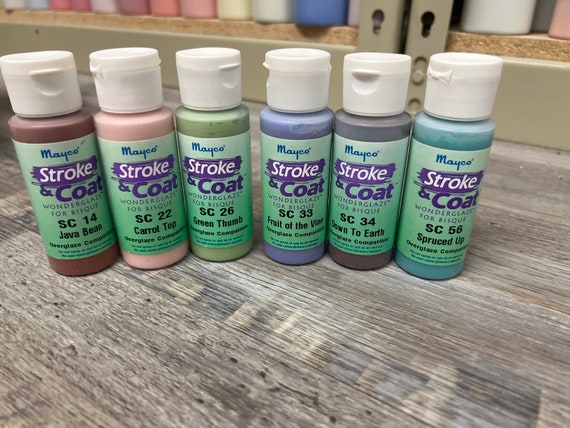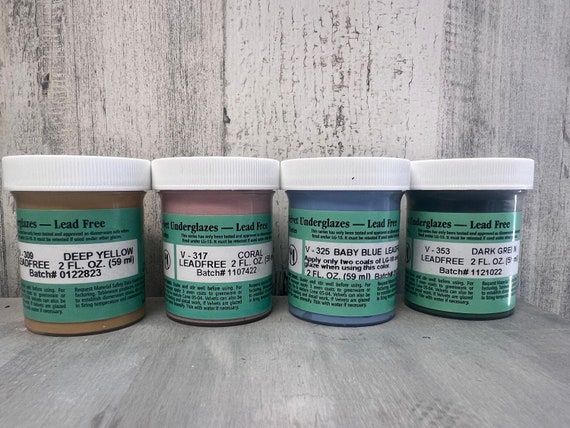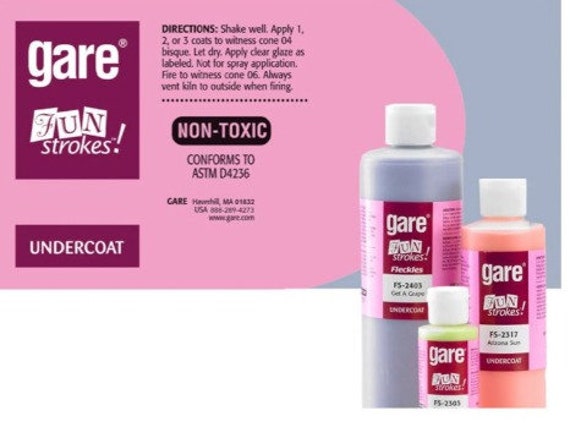Understanding the Basics of Underglaze and Stroke and Coat
When it comes to ceramic decorating, underglaze and stroke and coat are two techniques that every artist should know. Both methods offer unique ways to add color and design to pottery, enhancing its visual appeal. Understanding these approaches is essential for potters looking to elevate their creations.
Underglaze is typically applied before a clear glaze, allowing intricate designs to shine through after firing. In contrast, stroke and coat is a more versatile technique that can be used both as a decorative layer and the final finish. Each method has its own charm and countless possibilities for creativity.
In this article, we will explore the differences between underglaze and stroke and coat, examining their advantages, disadvantages, and practical applications. Whether you are a novice or an experienced ceramic artist, this guide will deepen your understanding and inspire your next project.



Mastering Underglaze: Essential Techniques for Ceramic Artistry
What is Underglaze?
Underglaze is a fascinating ceramic decorating method that acts as a canvas for your creativity. Essentially, it consists of colored slips that are applied directly onto bisque-fired clay. This technique allows artists to create intricate designs, patterns, and images that become part of the pottery itself, rather than just a superficial layer.
Composition and Application
Underglaze is composed of clay, water, and pigment, giving it a smooth consistency that makes application easy and attractive. Typically, it comes in various forms: liquid, pencil, or even in dry powder form. Depending on the specific underglaze product, it may be applied in different ways, including:
Once applied, underglaze must be fired at a temperature that adheres it to the clay body. After a bisque firing, a clear glaze is often used on top, allowing the vibrant colors of the underglaze to shine through, achieving a beautiful, glossy finish.
Characteristics of Underglaze
One of the most attractive features of underglaze is its versatility. Artists can achieve diverse effects, from delicate watercolor-like washes to bold, opaque colors. Here are a few key characteristics:
For those looking to experiment with underglaze, products like the Amaco Velvet Underglazes in 2oz Bottles can offer a fantastic starting point, with a wide range of colors that bring out your artistic vision.
As we delve deeper into ceramic techniques, understanding what underglaze can offer sets the stage for comparing it with another popular method: stroke and coat. Stay tuned for a look at this versatile technique and how it contrasts with the unique characteristics of underglaze.
What is Stroke and Coat?
Stroke and coat is an exciting ceramic glazing technique that provides both versatility and brilliant finishes to your pottery. Unlike traditional underglaze, stroke and coat products serve as both a decorative layer and a final topcoat, eliminating the need for multiple applications. This method allows artists to infuse their work with easy-to-apply, vivid colors directly onto their ceramic pieces.
Composition and Characteristics
Stroke and coat glazes are generally made with a blend of high-quality pigments and a base of ceramic materials, forming a thicker, more opaque consistency than underglaze. These glazes come in myriad colors, offering a vibrant palette that inspires creativity.
The most remarkable feature of stroke and coat glazes is their ability to produce a range from transparent to opaque finishes without requiring a clear glaze on top. Once fired, these products yield a glossy sheen, enhancing the depth of the colors and ensuring a durability that withstands both use and time.
Application Techniques
Applying stroke and coat is straightforward, making it perfect for artists of all skill levels. Here are some popular techniques:
Unique Results
The beauty of stroke and coat lies in its ability to create vibrant, smooth finishes with minimal effort. Artists often report how easy it is to layer these glazes, allowing for imaginative patterns and designs that might be more challenging with traditional underglaze. One can even incorporate techniques such as ‘pointillism’ or ‘splatter’ to achieve playful, dynamic results.
For those wanting to integrate stroke and coat into their practice, consider exploring product options like the popular 13 Color Ceramic Underglaze Paint Set. This set offers a wonderful array of colors tailored for stroke and coat applications, allowing you to delve into your artistic expression right away.
In our next section, we will engage in a comparative analysis, diving deeper into the similarities and differences between underglaze and stroke and coat. This understanding will enable you to make informed decisions on which technique best suits your creative vision.
Comparative Analysis of Underglaze and Stroke and Coat
When considering the use of underglaze and stroke and coat, it’s important to recognize the distinct differences that can guide artists in their choice of techniques. Here, we’ll conduct a side-by-side comparison, examining their properties, application methods, and firing requirements to help you determine the best fit for your artistic needs.
Properties and Characteristics
Application Processes
Ideal Use Cases
Think about the application. If you want to create a piece that flaunts fine details and multiple colors that layer seamlessly, underglaze may be the better choice. However, if you prefer a straightforward approach with bold, shiny results, stroke and coat will likely meet your artistic needs.
This analysis provides a clearer view of how these techniques stack up against one another, allowing artists to make educated choices based on their project goals and personal preferences. Next, we will explore the advantages and disadvantages of each approach, further helping to refine your decision-making process as you embark upon your creative journey.
Advantages and Disadvantages of Each Technique
As we weigh the strengths and weaknesses of underglaze and stroke and coat, it becomes evident that both techniques have unique attributes that appeal to different artistic styles and project needs. Here, we will explore the pros and cons of each to help you navigate these options.
Underglaze: Advantages and Disadvantages
Advantages:
Disadvantages:
Stroke and Coat: Advantages and Disadvantages
Advantages:
Disadvantages:
Both techniques present their own unique blend of advantages and challenges, offering a range of possibilities for expression in ceramic art. Understanding these factors will prepare you for our next section, where we will discuss practical applications and tips for artists—helping you make the most of your chosen method in your creative journey.
Practical Applications and Tips for Artists
When it comes to selecting between underglaze and stroke and coat, making an informed decision can enhance your pottery projects significantly. Here are practical tips and considerations based on artistic needs and project specifics, as well as suggestions to ensure successful application of each technique.
Choosing the Right Technique for Your Project
Tips for Successful Application
Underglaze Tips:
Stroke and Coat Tips:
Project Ideas for Each Technique
By understanding your project requirements and applying these tips, you can navigate the artistic landscape of ceramics with confidence. Whether you choose the delicate precision of underglaze or the vibrant finish of stroke and coat, the right approach will breathe life into your artistic vision.
As we draw closer to our conclusion, it’s time to reflect on how these insights can assist you in making the best choice for your creative endeavors.
Making the Right Choice: Underglaze or Stroke and Coat?
In summary, understanding the differences between underglaze and stroke and coat is essential for any ceramic artist aiming to achieve specific artistic effects. Each technique offers unique characteristics—underglaze provides depth and intricate detail, while stroke and coat allows for vibrant, glossy finishes.
We encourage you to explore both methods in your creative journey. Experimenting with underglaze and stroke and coat will not only enhance your skills but also lead you to discover a style that resonates with your artistic voice. Ultimately, the right choice depends on your vision and the effects you wish to create—so get started and enjoy the process!








I never knew there was such a difference between underglaze and Stroke and Coat! 🤯 I’ve only ever used Stroke and Coat because I thought it was easier for beginners. But now I’m tempted to try underglaze! Anyone have experience with the Amaco Velvet Underglazes? Are they worth it?
Great question, Sarah! The Amaco Velvet Underglazes are popular for a reason. They offer a nice matte finish and are quite versatile!
I’ve used the Amaco ones and they’re amazing! Super vibrant colors. Just remember to seal them, or they can fade a bit.
Thanks for the article! I’ve always been confused about which to use. I think I’ll go with Stroke and Coat for my next project. I’ve got the Gare Fun Strokes Pottery Paint Set, so let’s see how that goes!
Good choice! The Gare set is pretty user-friendly. Just have fun with it!
Glad you found the article helpful, Rachel! Enjoy your painting!
Okay, so I’m a complete newbie and this article has me feeling a little overwhelmed. 😅 Is there a cheat sheet for choosing between these two? I just want to paint some mugs for my friends without going crazy!
Haha, I feel you! I started with Stroke and Coat because it’s a bit more forgiving. Maybe start there?
Tommy, I recommend trying out both in small projects, like tiles or coasters, before committing to a larger piece.
Stroke and Coat is my jam! I love that I can just whip it out and paint without worrying too much about the details. 😂 But I’m curious, can it be used over underglaze?
Correct, Chris! Just be cautious with the firing temperature; it might affect the finish.
Yes, you can! Just make sure the underglaze is completely dry before applying the Stroke and Coat.
I just ordered the 13 Color Ceramic Underglaze Paint Set, and I can’t wait to try it out! 🎨 Any tips for a newbie? What should I be cautious about?
Make sure to test on a scrap piece first! It can look different once fired. And don’t forget to layer!
Good luck, Megan! Testing is key, and remember to read the firing instructions for best results.
I’ve been using underglaze for a while, but honestly, it can be a bit tricky. The drying time drives me nuts sometimes. I love how vibrant the colors can be, but does anyone else struggle with the application?
Good point, Emily! Practice really helps, and remember to work in thin layers to avoid streaks.
Yes! I find that the underglaze can get streaky if I’m not careful. But once you find your groove, it’s so worth it!
I’m still figuring out the difference, but I really want to try that Versatile Pottery Underglaze Marker Pen I saw on Etsy. Has anyone used it? How’s the control with it?
The marker is fantastic for details! I love using it for outlines before filling in with underglaze.
Yes, the marker gives you great precision! It’s perfect for those fine details.
I honestly find both techniques useful in different ways. For intricate designs, I prefer underglaze, but for quick projects, Stroke and Coat is unbeatable. Anyone else feel the same?
Totally! I think it’s all about what you’re trying to achieve. Mixing both techniques can lead to some cool effects.
I agree, Laura! Combining techniques can definitely elevate your work.